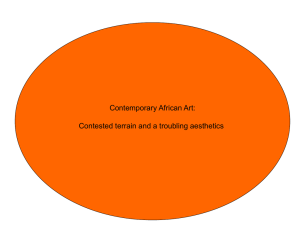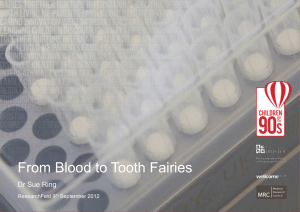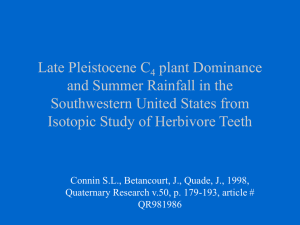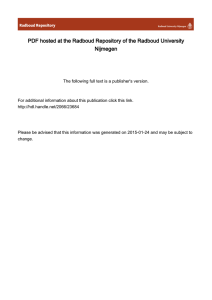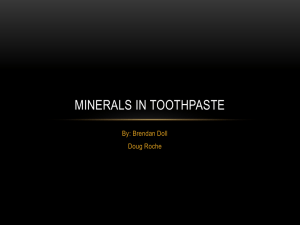Tooth enamel defects and infant stress. In
advertisement
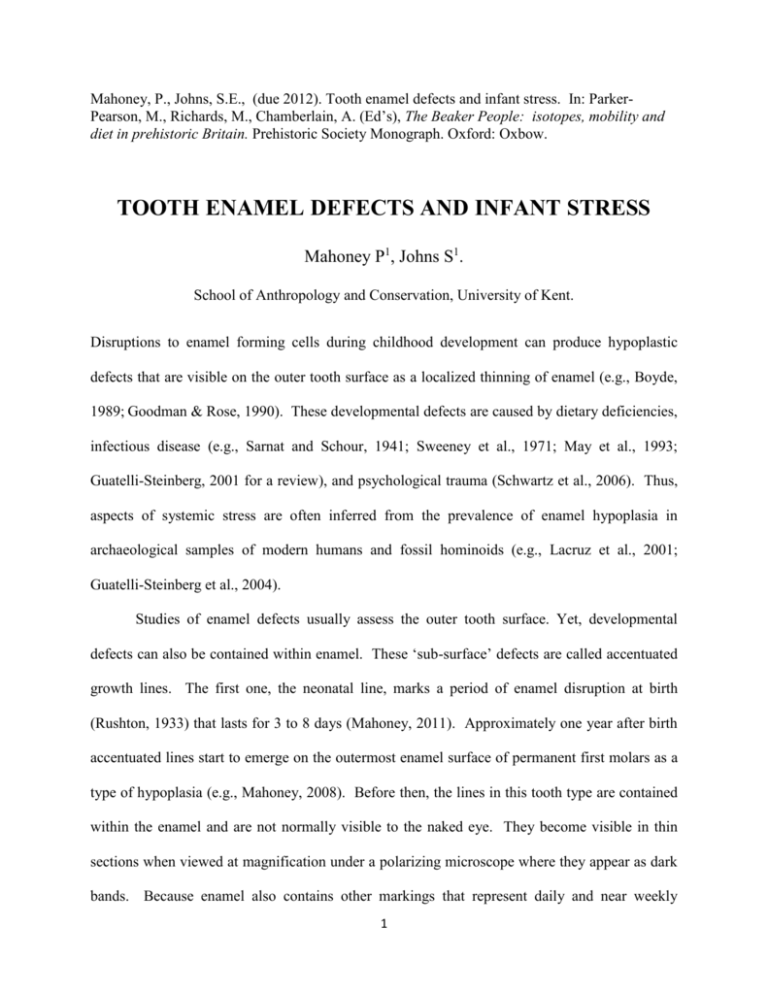
Mahoney, P., Johns, S.E., (due 2012). Tooth enamel defects and infant stress. In: ParkerPearson, M., Richards, M., Chamberlain, A. (Ed’s), The Beaker People: isotopes, mobility and diet in prehistoric Britain. Prehistoric Society Monograph. Oxford: Oxbow. TOOTH ENAMEL DEFECTS AND INFANT STRESS Mahoney P1, Johns S1. School of Anthropology and Conservation, University of Kent. Disruptions to enamel forming cells during childhood development can produce hypoplastic defects that are visible on the outer tooth surface as a localized thinning of enamel (e.g., Boyde, 1989; Goodman & Rose, 1990). These developmental defects are caused by dietary deficiencies, infectious disease (e.g., Sarnat and Schour, 1941; Sweeney et al., 1971; May et al., 1993; Guatelli-Steinberg, 2001 for a review), and psychological trauma (Schwartz et al., 2006). Thus, aspects of systemic stress are often inferred from the prevalence of enamel hypoplasia in archaeological samples of modern humans and fossil hominoids (e.g., Lacruz et al., 2001; Guatelli-Steinberg et al., 2004). Studies of enamel defects usually assess the outer tooth surface. Yet, developmental defects can also be contained within enamel. These ‘sub-surface’ defects are called accentuated growth lines. The first one, the neonatal line, marks a period of enamel disruption at birth (Rushton, 1933) that lasts for 3 to 8 days (Mahoney, 2011). Approximately one year after birth accentuated lines start to emerge on the outermost enamel surface of permanent first molars as a type of hypoplasia (e.g., Mahoney, 2008). Before then, the lines in this tooth type are contained within the enamel and are not normally visible to the naked eye. They become visible in thin sections when viewed at magnification under a polarizing microscope where they appear as dark bands. Because enamel also contains other markings that represent daily and near weekly 1 growth increments (e.g., Risnes, 1990; Bromage, 1991) the timing of accentuated lines can be accurately calculated. Thus, chronological patterns of infant stress can be reconstructed from adult permanent enamel. Previous histological studies have examined accentuated growth lines in human deciduous (e.g., FitzGerald and Saunders, 2005) and non-human fossil and extant primate teeth (e.g., Macho et al., 1996; Dirks et al., 2002, 2010). The aim of this study is to calculate the timing of accentuated lines in a sample of permanent human teeth to reconstruct the chronology of stress events in the first postnatal year. The timing and the cause of the lines will be discussed. Materials Twelve erupted but unworn permanent lower first mandibular molars were selected from human juvenile skeletons recovered from previously excavated archaeological sites in England and Scotland. First molars rather than canines (e.g., Rose et al., 1978) were chosen because of the permanent teeth, only first molar enamel initiates before birth and thus contains a neonatal line. These samples are from the Beaker People project database, skeletal numbers 11, 14, 31, 36, 57, 59, 60, 75, 80, 82, 100, 105. For database skeletal numbers 60, 75, 80, and 82, the cuspal enamel was complete before the end of the first postnatal year, thus accentuated lines were recorded in the cuspal continuing into the lateral enamel (Fig.1). 2 Methods The molars were previously sectioned for a study of modern human molar enamel growth rates (Mahoney, 2008). Each molar was embedded in polyester resin to reduce the risk of splintering while sectioning. Using a diamond-wafering blade (Buehler® IsoMet 1000) buccallingual sections were taken through the tip of the protoconid cusp enamel and tip of the enameldentin junction (EDJ). Section obliquity was minimized following methods discussed by Mahoney (2010). Each section was mounted on a microscope slide, lapped using a graded series of grinding pads (Buehler®IsoMet 1000) to reveal the accentuated and other incremental lines, polished with a 0.3mm aluminum oxide powder, placed in an ultrasonic bath to remove surface debris, dehydrated through a series of alcohol baths, cleared (Histoclear®), and mounted with a cover slip using a xylene-based mounting medium (DPX®). Sections were examined under a high powered microscope (Olympus BX51) using transmitted and polarized light. Images were captured (Olympus DP25) and analyzed (Olympus Cell D). The distance between the neonatal line in cuspal enamel and the next accentuated line (also called Wilson bands and accentuated Retzius lines in the literature) was measured along the long axis of a prism (see Fig. 2; and see FitzGerald et al., 2006 for a discussion of accentuated marking identification). This distance was divided by a local daily enamel secretion rate (DSR) to give the amount of time elapsed in days from birth. The procedure was repeated on subsequent markings to establish a chronology of stress events (e.g., Macho et al., 1996). Daily enamel secretion rates were calculated by measuring a distance corresponding to five days of enamel secretion along a prism, which was then divided by five to yield a mean daily rate (e.g., 3 Mahoney, 2008: Fig 3-4). The procedure was repeated a minimum of six times, which allowed a mean DSR value to be calculated. Prism lengths divided by DSRs were used to estimate the time elapsed between accentuated markings in lateral enamel (see Mahoney et al., 2007 for a description). The frequency of accentuated markings from birth was recalculated into monthly intervals. The prevalence of the markings was recalculated following Waldron (1994): Prevalence = number of individuals with condition x x 100 (expressed as a percentage) total population Results The greatest frequency and prevalence of accentuated markings occurred in the ninth and tenth post natal month. Table 1 shows the timing of the first accentuated line after birth. Table 2 shows the frequency of accentuated lines in months through the first postnatal year. Figure 2 shows accentuated lines in Beaker People project database skeletal number 14. Figures 3-4 show frequency and prevalence bar charts. 4 Discussion The timing of accentuated lines was calculated in first molar enamel, thus reconstructing the age at which stress events occurred during the first postnatal year in an archaeological sample of modern human infants from England and Scotland. This has provided a record of infant health from adult permanent tooth enamel that is not normally visible to the naked eye. Thus histological examination of permanent first molars provides an alternative methodological approach when deciduous teeth are either not present or the enamel is too worn for this type of analysis. The timing of the stress events reported here differ compared to FitzGerald and coauthor (2006), who examined accentuated markings in a sample of human deciduous teeth from an Imperial Roman Necropolis. They reported a period of high prevalence in the second through to the fifth postnatal month, and another period of greater prevalence beginning in the sixth continuing through to the ninth month. In the present study, line prevalence gradually increased from the second through to the fifth month, but the overall frequency in each month was low. In contrast to the infants from the Necropolis, the greatest prevalence of stress events occurred in the ninth and tenth post-natal month. Differences in the age-at-death profiles between these studies suggest one factor that may have contributed to the difference in the timing of the stress events. In the study by FitzGerald and coauthors (2006) most of the children died in their second year. Here, the juveniles survived into at least their third year because permanent first molar cervical enamel was complete (Mahoney, 2008). Therefore, differences in life-expectancy between the two infant populations may reflect differences in the stresses experienced during their first year. 5 The cause of the developmental defects is difficult to determine with certainty because accentuated markings form in response to multiple stressors. With this in mind, high frequencies of accentuated lines in non-human primate tooth enamel can correlate with a life history event, weaning (Dirks et al., 2010), the age at which food other than breast milk is introduced into the diet (mixed feeding) or breast feeding eventually ceases. A shift from exclusive suckling to a mixed feeding strategy is potentially beneficial for infant brain development and growth as it allows access to foods that are higher in protein and calories than maternal milk (Kennedy 2005) as well as the inclusion of specific key micronutrients in the diet (Davies 2004). However, as breast milk intake is reduced in favour of other foods there is an increased risk of exposure to food borne pathogens and intestinal parasites (Black et al. 1981; Motarjemi et al. 1993), being unable to digest adult food efficiently (Kennedy 2005), tooth wear (Ayers et al. 2002), kawashiorkor (Walker 1990), and conditions related to vitamin deficiency (West et al. 1986). This tradeoff is known as ‘the weanling’s dilema’ (Rowland et al. 1978). If the transition to a mixed feeding strategy is poorly regulated and weaning food preparation is unhygienic, the costs of including solid food in the diet will outweigh the benefits, and will only serve to increase infant nutritional stress, sickness, and mortality. In addition to high frequencies of accentuated lines, weaning age can correlate with other dental defects. For example, increased frequencies of surface hypoplastic defects have been associated with the age at which infant mixed feeding commences in living human populations (Alcorn and Goodman, 1985; Goodman et al., 1987), and to textual evidence of weaning in archaeological samples of modern humans dating to the historic periods (e.g., Moggi-Cecchi et al., 1994) though this latter association is not always consistent (e.g., Wood, 1996). Other 6 animals show a similar relationship between surface hypoplasia and weaning (Franz-Odendaal, 2004; Dobney et al., 2005). For the infant sample studied here, none of the children displayed indicators of stress in the month after birth, but this was followed by a gradual increase in stress until it peaked at 10 months of age. This suggests that the timing of these tooth enamel defects might reflect, in part, a gradual weaning process in this population starting at approximately 6-7 months, with weaning stress peaking at 10 month. Some traditional societies begin to supplement milk feeds with weaning foods in the second half of the first year (Kennedy 2005), and there are developmental changes of the mandible and teeth that occur at a similar time (Humphrey 2009) making a mixed feeding strategy possible. Stable isotope findings for Iron Age Yorkshire also suggest a weaning strategy (Jay et al., 2008) that is comparable to the one proposed here. Infant milk intake at this site may have been supplemented by animal and / or plant foods from a very early age because δ15N values through the first year were not elevated to the extent expected for exclusive breastfeeding (Jay et al., 2008: see their Fig.4; also see Herring et al., 1998 for a similar example from the historic periods). Thus, while we cannot exclude the possibility that the tooth enamel defects reported here formed in response to trauma or infectious disease unrelated to diet, the timing of the accentuated lines in this sample are consistent with a gradual process of weaning that led to dietary deficiencies and increased illness and disease. 7 Literature cited Alcorn MC, Goodman AH. 1985. Dental enamel defects among contemporary nomadic and sedentary Jordanians. American Journal of Physical Anthropology. 66: 139 Ayers KM, Drummond BK, Thomson WM, Kieser JA. 2002. Risk indicators for tooth wear in New Zealand school children. International Dental Journal 52:41–6. Black RE, Brown KH, Becker S, Alim AR and Merson, MH. 1981. Contamination of weaning foods and transmission of enterotoxigenic Escherichia coli diarrhoea in children in rural Bangladesh. Transactions of the Royal Society of Tropical Medicine and Hygiene 76: 259-264. Boyde A. 1989. Enamel. In: Oksche, A., Vollrath, L. (Eds.), Handbook of microscopic anatomy, vol.V/6: Teeth. Springer-Verlag,Berlin, pp. 309-473. Bromage TG. 1991. Enamel incremental periodicity in the pigtailed macaque: a polychrome fluorescent labelling study of dental hard tissues. Am J PhysAnthropol 86:205–214. Davies DP and O'hare B. 2004. Weaning: A worry as old as time. Current Paediatrics 14: 83-96. Dirks W, Humphrey LT, DeanM C, Jeffries TE. 2010. The Relationship of Accentuated Linesin Enamel to Weaning Stress in JuvenileBaboons (Papiohamadryasanubis). Folia Primatol 2010;81:207–223 Dirks W, Reid DJ, Jolly CJ, Phillips-Conroy JE, Brett FL. 2002. Out of the Mouths of Baboons: Stress, Life History, and Dental Development in theAwash National Park Hybrid Zone, Ethiopia. American Journal of Physical Anthropology 118:239–252 Dirks W, Humphrey LT, Dean MC, Jeffries TE. 2010. The Relationship of Accentuated Lines in Enamel to Weaning Stress in Juvenile Baboons (Papio hamadryas anubis). Folia Primatol 2010; 81:207–223. 8 Dobney K, Ervynck A, Albarella U, Rowley-Conwy P. 2004. The chronology and frequency of a stress marker (linear enamel hypoplasia) in recent and archaeological populations of Sus scrofa in north-west Europe, and the effects of early domestication. Journal of Zoology.264: 197–208. FitzGerald CM, Saunders SR. 2005. Test of histological methods of determining chronology of accentuated striae in deciduous teeth. American Journal of Physical Anthropology 127: 277–290 FitzGerald CM, Saunders S, Bondioli L, Macchiarelli R. 2006. Health of Infants in an Imperial Roman Skeletal Sample: Perspective from Dental Microstructure. American Journal of Physical Anthropology 130: 179–189 Franz-Odendaal, TA. 2004. Enamel hypoplasia provides insights into early systemic stress in wild and captive giraffes (Giraffa camelopardalis). Journal of Zoology, 263: 197-206 Goodman AH, Allen LH, Hernandez GP, Amador A, Arriola LV, Chavez A, and Pelto GH (1987) Prevalence and age at development of enamel hypoplasias in Mexican children. American Journal of Physical Anthropology. 72: 7-19. Herring DA, Saunders SR, Katzenberg MA. 1998. Investigating the Weaning Process in Past Populations. American Journal of Physical Anthropology 105:425–439 Humphrey LT. 2010. Weaning behaviour in human evolution. Seminars in Cell & Developmental Biology 21:453-461. Jay M, Fuller BT, Richards MP, Knusel CJ, King SS. 2008. Iron Age Breastfeeding Practices in Britain: Isotopic Evidence From Wetwang Slack, East Yorkshire. American Journal of Physical Anthropology. 136: 327–337. Goodman AH, Rose JC. 1990. Assessment of systemic physiological perturbations from dental enamel hypoplasias and associated histological structures. Yearbook of Physical Anthropology 33: 59–110. 9 Guatelli-Steinberg D, Larsen CS, Hutchinson DL. 2004. Prevalence and the duration of linear enamel hypoplasia: A comparative study of Neandertals and Inuit foragers. Journal of Human Evolution 47: 65-84. Guatelli-Steinberg D. 2001. What can developmental defects of enamel reveal about physiological stress in nonhuman primates? Evolutionary Anthropology 10:138–151. Katzenberg MA, Herring DA, Saunders SR. 1996. Weaning and Infant Mortality: Evaluating the Skeletal Evidence. Yearbook of physical anthropology 39:177-199 Kennedy G E. 2005. From the ape's dilemma to the weanling's dilemma: Early weaning and its evolutionary context. Journal of Human Evolution 48:123-145. Lacruz RS, Ramirez Rozzi F, Bromage TG. 2005. Dental enamel hypoplasia, age at death, and weaning in the Taung child. South African Journal of Science. 101: 567-569. Macho GA, Reid DJ, Leakey MG, Jablonski N, Beynon D. 1996. Climatic effects on dental development Mahoney P, Smith TM, Schwartz GT, Dean C, Kelley J. 2007. Molar crown formation in the Late Miocene Asian hominoids, Sivapithecusparvada and Sivapithecusindicus.Journal of Human Evolution 53:61-68. Mahoney P. 2008. Intraspecific variation in M1 enamel development in modern humans: implications for human evolution. Journal of Human Evolution.55: 130-146. Mahoney P. 2010. Two dimensional patterns of human enamel thickness on deciduous (dm1, dm2) and permanent first mandibular molars. Archives of Oral Biology55:115-126 Mahoney P. 2011. Human deciduous mandibular molar incremental enamel development. American Journal of Physical Anthropology. 144:204–214 10 May RL, Goodman AH, and Meindl RS (1993) Response of bone and enamel formation to nutritional supplementation and morbidity among malnourished Guatemalan children. American Journal of Physical Anthropology 92: 37-51. Moggi-Cecchi J, Pacciani E, Pinto-Cisternas J. 1994. Enamel Hypoplasia and Age at Weaning in 19th-Century Florence, Italy. American Journal of Physical Anthropology 93:299-306. Motarjemi Y, Käferstein F, Moy G, and Quevedo F. 1993. Contaminated weaning food a major risk factor for diarrhoea and associated malnutrition. Bulletin of the World Health Organization 71:79–92. Richards MP, Mays S, Fuller BT. 2002. Stable carbon and nitrogen isotope values of bone and teeth reflect weaning age at the Medieval Wharram Percy site, Yorkshire, UK. American Journal of Physical Anthropology 119:205–210. Risnes, S., 1990. Structural characteristics of staircase-type Retzius lines in human dental enamel analyzed by scanning electron microscopy.Anatomical Record 226: 135-146. Rose JC, Armelagos GJ, Lallo JW. 1978. Histological enamel indicator of childhood stress in prehistoric skeletal samples. American Journal of Physical Anthropology. 49: 511–516 Rowland MGM, Barrell, RAE and Whitehead, RG. 1978. Bacterial contamination in traditional Gambian weaning foods. Lancet 311: 136 -138. Rushton MA. 1933. Fine contour lines of enamel milk teeth. Dent Res 53:170. Sarnat B.G. and Schour I. (1941). Enamel hypoplasias (chronologic enamel hypoplasia) in relation to systemic diseases: achronological, morphological and etiological classification. Journal. American. Dental. Assocication. 28: 1989–2000. Schwartz GT, Reid DJ, Dean MC, Zihlman AL. 2006. A faithful record of stressful life events preservedin the dental developmental record of a juvenile gorilla. International Journal of Primatology 27:1201–1219. 11 Sweeney EA, Saffir JA, de Leon R. 1971. Linear hypoplasia of deciduous incisor teeth in malnourished children. Am J Clin Nutr 24:29–31. Waldron HA. 1994. Counting the dead. Chichester: John Wiley. Walker AF. 1990. The Contribution of Weaning Foods to Protein–Energy Malnutrition. Nutrition Research Reviews, 3: 25-47 West, KP Jr, Chirambo M, Katz J and Sommer A. 1986. Breast-feeding, weaning patterns, and the risk of xerophthalmia in Southern Malawi. American Journal of Clinical Nutrition 44:690697 Wood L (1996) Frequency and chronological distribution of linear enamel hypoplasia in a North American colonial skeletal sample. American Journal of Physical Anthropology 100: 247-260. 12
